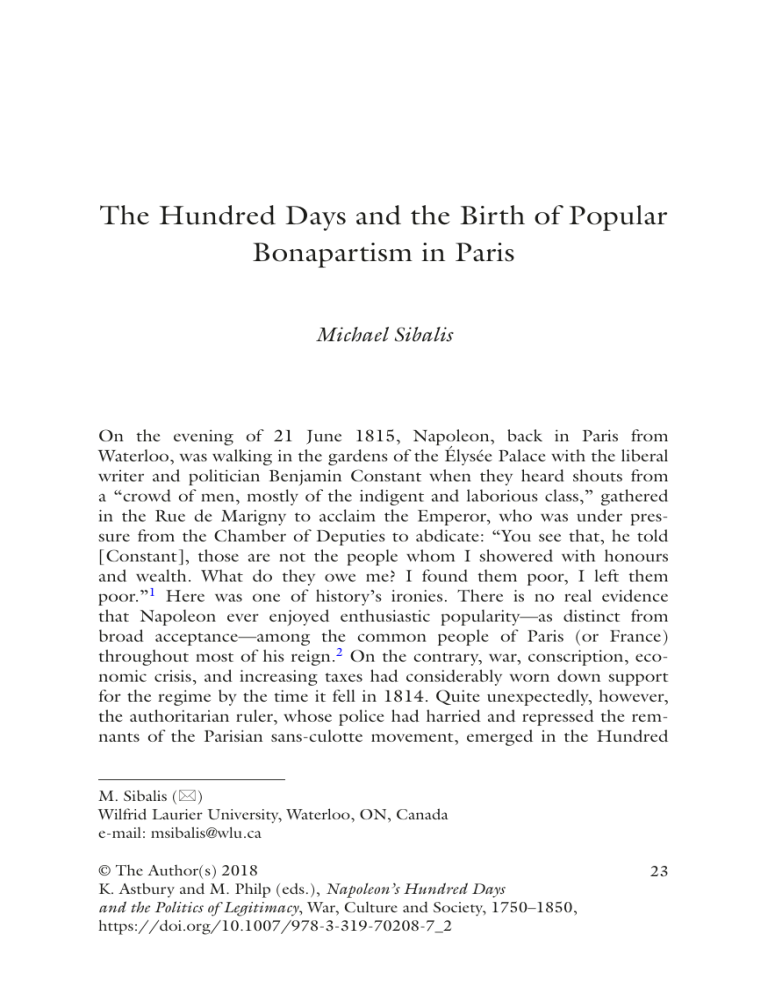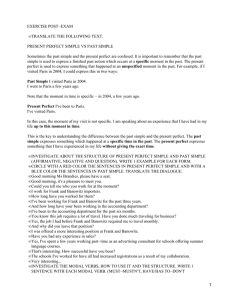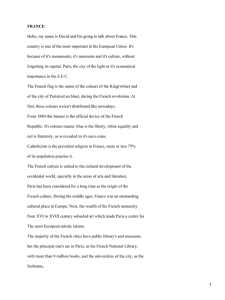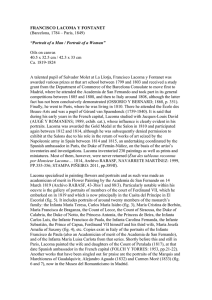
The Hundred Days and the Birth of Popular Bonapartism in Paris Michael Sibalis On the evening of 21 June 1815, Napoleon, back in Paris from Waterloo, was walking in the gardens of the Élysée Palace with the liberal writer and politician Benjamin Constant when they heard shouts from a “crowd of men, mostly of the indigent and laborious class,” g ­ athered in the Rue de Marigny to acclaim the Emperor, who was under pressure from the Chamber of Deputies to abdicate: “You see that, he told [Constant], those are not the people whom I showered with honours and wealth. What do they owe me? I found them poor, I left them poor.”1 Here was one of history’s ironies. There is no real evidence that Napoleon ever enjoyed enthusiastic popularity—as distinct from broad acceptance—among the common people of Paris (or France) ­throughout most of his reign.2 On the contrary, war, conscription, economic crisis, and increasing taxes had considerably worn down support for the regime by the time it fell in 1814. Quite unexpectedly, however, the ­authoritarian ruler, whose police had harried and repressed the remnants of the Parisian sans-culotte movement, emerged in the Hundred M. Sibalis (*) Wilfrid Laurier University, Waterloo, ON, Canada e-mail: msibalis@wlu.ca © The Author(s) 2018 K. Astbury and M. Philp (eds.), Napoleon’s Hundred Days and the Politics of Legitimacy, War, Culture and Society, 1750–1850, https://doi.org/10.1007/978-3-319-70208-7_2 23 24 M. Sibalis Days under a new guise and with fervent support from the city’s common people. Historian Frédéric Bluche has labeled the phenomenon “Jacobin Neo-Bonapartism.”3 In the words of a royalist pamphleteer, “[Napoleon] had thus rejoined the Jacobin Club, he had thereby agreed to swap his imperial crown for the frightful red liberty cap and his imperial title for that of general of patriots.”4 The explanation for this development lies in the First Restoration, the ten months between Louis XVIII’s entry into Paris (3 May 1814) and Napoleon’s return (20 March 1815). The restored Bourbons were unpopular with the Parisian masses from the start. As early as 6 April 1814 (the day Napoleon abdicated), René de Chateaubriand’s sister described “the rabble” (la canaille) as “insolent and very brazen”; no one (she said) dared wear the white cockade in certain (unidentified) Paris faubourgs (peripheral districts inhabited predominantly by artisans and workers), where posters announcing her brother’s pamphlet ­backing the monarchy were smeared with excrement.5 However, the police (initially at least) expected that peace, prosperity, and full employment would eventually win over Paris’ workers.6 Furthermore, as the DirectorGeneral of Police suggested in October 1814, Napoleon had turned the city’s “working classes” into passive spectators of political events. They purportedly cared only about earning a living, and this “egoism” and “servile obedience,” forced on them by fifteen years of dictatorship “are for the [present] government the strongest guarantee of its tranquillity, which is complete in the capital.”7 Police reports on public opinion during the First Restoration are on the whole vague and reassuring, like this one from August 1814: “These faubourgs [St. Antoine and St. Marcel] are under constant surveillance; there is nothing seen there that can give the least concern.”8 However, many of these reports also record numerous incidents—relatively minor, to be sure, but telling when taken together—that suggest a different picture.9 Indeed, by the late autumn of 1814 police agents were appalled by what they were overhearing: “In those places where the common people gather, such as wine shops in particular, workers and the lower class, when speaking of the Government, express themselves with a freedom and an indecency that prove that the people are being … stirred up and strongly stirred up.”10 Dissatisfaction was particularly acute among ­veterans and demobilized soldiers, who grumbled about the poor treatment they felt they were receiving from the new government. Former soldiers recalled with pride “the days when they marched from victory THE HUNDRED DAYS AND THE BIRTH OF POPULAR BONAPARTISM … 25 to victory” and they were openly loyal to the dethroned Emperor.11 For instance, two assistant pastry chefs (garçons patissiers) recently returned from the army were heard (in August 1814) “to utter the most insolent words against His Majesty, and to praise Bon*** to the skies; they long for his return, in which they believe.”12 However, such discontent went far beyond one-time soldiers. On one day, for example (29 September 1814), the police arrested both a drunken carter as he walked along the Seine shouting “Long live Napoléon!” and a cotton worker who refused to doff his cap when the King passed by in the Tuileries Gardens.13 It was not unusual for drunken workers to sing songs praising Napoleon, and the revolutionary song La Marseillaise could be heard “on all sides.”14 According to one report, port workers “are in general men of the lowest class, among whom there are many admirers of Bonaparte.”15 Louis XVIII on his throne implicitly challenged the French revolutionary tradition in a way that Napoleon’s monarchy had not. The police arrested a shoemaker named Maillefer for saying that “we should do to the fat pig [Louis XVIII] what we did to his brother [Louis XVI] and make him look through the lunette [of the guillotine] to see if Napoleon is coming back.”16 Placards on the walls of the capital insulted the King, lauded Napoleon, and demanded work and bread.17 As this suggests, economic woes added to the discontent. In a petition dated 30 May 1814, ten Parisian workers in the building trades predicted that “if the workers … were employed, all these murmurs of misery would cease, gaiety would reign, and the wise and beneficent government would be blessed.”18 Instead, police reports indicate a general decrease of wages through the summer of 1814.19 The earnings of cotton workers in the Faubourg Saint-Antoine fell by half, “which causes them to contrast the past to the present,”20 while journeymen carpenters repeated rumours that their employers had bribed the King to permit lower wages and longer working hours.21 Wage-earners blamed the new regime for their economic distress.22 An engraver named Langlé and his wife kept a bust of Napoleon in his workshop; “these two individuals complain that since the arrival of His Majesty, the workers have had their wages reduced by half.”23 The Minister of the Interior himself believed that it was “impolitic” of the monarchy not to continue the public works program “to which the last government had accustomed the people of the capital.”24 Another destabilizing factor was rampant anti-clericalism. By the Napoleonic period, Christianity had lost its hold on Parisian workers, 26 M. Sibalis especially men.25 The First Restoration got off to a bad start by banning Sunday work on 7 June 1814, a measure resented by workers, who thus lost a day’s wages and in any case often preferred to take off Mondays (faire le lundi) if they could afford it, as well as shopkeepers, who disliked the loss of business hours.26 There were also disturbances in June when, for the first time since the Revolution, the government authori­ zed Corpus Christi processions in the streets and the National Guard forced people to kneel as the host passed by.27 By July, if the police can be believed, workers in the Faubourgs Saint-Antoine and SaintMarcel “speak endlessly of Bonaparte who, they say, did not support the priests.”28 Two months later, police informants reported overhearing workers gathered on the Quai de Gesvres complaining that priests were seeking to regain their former prerogatives from the King.29 In January 1815, when the curé of Saint-Roch refused to conduct burial services for the actress Mademoiselle Raucourt, a mob estimated at eight- or nine-thousand-strong forcibly brought her coffin into his church. The curé was subsequently insulted in the streets when visiting his counterpart at Sainte-Marguerite in the Faubourg Saint-Antoine, while people mocked a group of priests skating on the frozen Ourcq Reservoir and pelted them with snowballs and rocks. The police were at a loss to explain this reaction among the common people, most of whom (they noted) could not have been familiar with the celebrated actress. Although downplaying the incident’s political significance (“it’s neither a Bonapartist operation nor an anti-royalist undertaking”), they nonetheless commented: “It’s the strangest explosion of the multitude’s hatred of the clergy … . There were veritable curses and swear-words ringing out everywhere.”30 Almost inevitably, support for Napoleon merged with the revolutionary tradition in the minds of many workers. A boot-maker named Pasque used to declaim against Napoleon when drunk; now he spoke out in his favour.31 Rocher, a shoemaker’s assistant, “who formerly ranted against Bon***’s government and did everything possible to get out of conscription” now “openly manifests his opposition to the King and announces the imminent return of Bon*** who will overthrow the Bourbons.”32 Fréché, a notoriously republican shoemaker, “did not like Bonaparte when he ruled, and now he speaks of him favourably.” He saw Napoleon’s return as a potentially revolutionary act that “would lead to further events.”33 Of course, not every rabid republican had suddenly turned Bonapartist, and many former “anarchists” held fast to their THE HUNDRED DAYS AND THE BIRTH OF POPULAR BONAPARTISM … 27 anti-Bonapartist sentiments.34 For instance, a man named Perrin, allege­ dly “one of the blood-thirsty terrorists of September 1792,” declared: “That madman Bonaparte has fallen; now we have to overthrow the King.”35 However, as the Director-General of Police recognized: “Every movement, every disorder, every agitation in France will be to [Napoleon’s] advantage, whatever even those who hate and fear him may say or think. The Republic, the Regency, or Bonaparte are more or less the same thing because, as long as he lives, he is the inevitable successor to any government that is not the legitimate one.”36 There was, in the event, no Parisian insurrection against the Bourbons, nor was there ever much likelihood of one. The lower classes lacked both program and leadership, and Napoleon was living in exile on Elba. News of his sudden return (known in Paris on 7 March 1815) changed the situation. According to a police informant, “the majority of the people, petty merchants and others got a fiendish pleasure from announcing the return of this ravenous tiger who will once again cover France with blood. Some said, we will rush to his side, others said that if he had no shelter, I would give up my bed to him with pleasu­re.”37 François Panot, a 23-year-old hatter, could not contain his joy and exulted: “That’s our corporal who is returning, he’s my Father. I will serve him unto death, we’ll have our turn and we’ll make the Royalists dance!”38 The authorities could no longer discount the possibility— albeit an undoubtedly exaggerated one—of a popular uprising in the capital.39 Curé Dubois of Sainte-Marguerite in the Faubourg SaintAntoine actually claimed that a repentant conspirator had revealed to him a plot to raise the district. Dubois immediately distributed a proBourbon flyer on 16 March, warning his parishioners not to be misled by “a crowd of foreigners and strangers.” That evening he delivered a special sermon reminding them of their duty to king, country, and church. However, the faubourg remained calm, and National Guard patrols reported nothing amiss.40 The curé’s attitude would not be forgotten nor forgiven by some parishioners. On 20 April, Napoleon’s police arrested a father and son, both cabinet-makers, for shouting in front of the church, “Down with the clergy, the curé is a Vendean who should be hanged, the church should be set on fire and burned down!”41 The Napoleon who returned to Paris on 20 March 1815 appeared to be, ideologically and politically, a very different man from the one who had left just eleven months earlier. The transformation occurred ­during the “Flight of the Eagle” from Golfe-Juan to Paris (1–20 March 1815).42 28 M. Sibalis As historian Rob Alexander explained, “along the route the Emperor had donned new clothing—he now appeared in the curious guise of archdefender of the Revolution,” a “conversion [that] was soon to prove embarrassing.”43 Whatever Napoleon really thought, by the time he reached Paris, he was, either sincerely or (more likely) not, pledged to the role of liberal, even revolutionary Emperor. As John Hobhouse, an Englishman living in Paris at the time would point out in urging his compatriots to recognize Napoleon’s re-established government, “Napoleon did not remount the throne by virtue of his previous popularity”. On the contrary, as the embodiment of French independence and popular sovereignty, he had “rallied the pride and self-love of France around his person.” “The Emperor,” he stressed, “is now the man of the people – the people are at the head of his ministry – the people compose his army – his cause is that of the people – and finally, it is against the people, more than against Napoleon, that the allies are now in arms.”44 The temper of Paris during the Hundred Days recalled the heady times of the Revolution. Pamphlets rolled off the presses with a strident rhetorical tone straight from the Year II (1793–94), and troops on review marched to the strains of La Marseillaise and Ça Ira, songs previously banned under the Empire because of their revolutionary content.45 Workingmen gathered regularly beneath the windows of the Tuileries Palace to acclaim the Emperor (of course, royalists claimed that they were paid to do so).46 In the café Montansier in the PalaisRoyal, “a tribune was erected as in the times of the revolution,—and male and female orators made the place echo with vive l’empereur, et la liberté!”47 Napoleon himself was ill-at-ease with the revolutionary energies that his return had unleashed, fearing that they would prove to be a double-edged sword. The ambiguity of the situation is best revealed by Napoleon’s uneasy relationship with the so-called “federations.” The “federative movement,” which spread rapidly across France, began spontaneously in mid-April in Brittany when the young middleclass men of Rennes organized to defend revolutionary principles and the Bonaparte dynasty against the Bourbons and the Allied powers. There were originally four distinct federations in Paris (a cause of great confusion both to contemporaries and to many historians). Three quickly merged into the fédération ouvrière (workers’ federation) or fédéréstirailleurs (federated skirmishers), a popular militia based in Paris’s artisanal and working-class faubourgs (peripheral districts). In contrast, the fédération de Paris (of which little is known) was overwhelmingly THE HUNDRED DAYS AND THE BIRTH OF POPULAR BONAPARTISM … 29 bourgeois in composition and limited its activities to issuing declarations of political support for the Napoleonic regime.48 The fédération ouvrière started when 3000 inhabitants of the Faubourg Saint-Antoine and Faubourg Saint-Marcel signed a pacte fédératif (federal pact) published on 10 May. In it they pledged themselves to defend French honour and liberty, declared the cause of the people to be “inseparable from that of our immortal Emperor,” and adopted as their rallying cry: “Long live the Nation! Long live Liberty! Long live the Emperor!” “We want to participate in the common defense; we offer our arms to the Emperor … . We are asking to be armed and organized… . We also want by our attitude to strike terror into the traitors who might once again wish for the debasement of their country… . We swear that the Capital will never again see the foreigner impose his laws.”49 They did not propose to take an active part in the coming military campaign against the Allies—that was the army’s job—–but to defend Paris alongside the middle-class National Guard as éclaireurs (scouts). Napoleon agreed to review the fédérés from the Faubourgs SaintAntoine and Saint-Marcel on Sunday morning, 14 May 1815. That morning hundreds of men gathered on the boulevard near the Place de la Bastille before marching in a column seven-to-eight men across to the Tuileries.50 Their social origins were obvious to every observer. The American statesman John Quincy Adams saw them pass along the boulevards: “There were about 3500 men and boys of the Fauxbourg St. Antoine and 1600 of the Fauxbourg St. Marceau, all labourers of the most indigent class. They marched in ranks of 20 holding one another arm in arm, and shouting incessantly ‘vive l’Empereur’.”51 John Cam Hobhouse, who witnessed the review itself, reported that “the greater part [were] in their labouring dresses and their dustman’s hats” and that “many of them [had] served [in the army].”52 A more-or-less official image of the event (published by Le Moniteur) depicts respectable ­artisans and workingmen enthusiastically acclaiming Napoleon as he rides through their ranks on horseback. In contrast, a Royalist caricature lampoons the men in a way that made them simultaneously both ridiculous (their ill-shaped bodies, their ragged and patched clothes) and menacing (their ferocious expressions, their swords and pikes).53 Their ideological leanings—for Bluche they were the very embodiment of Jacobin Neo-Bonapartism—were no less evident than their social origins.54 Their spokesman (a veteran soldier) addressed Napoleon as protector of revolutionary principles and national independence rather than autocrat or conqueror: 30 M. Sibalis We have welcomed you enthusiastically because you are the representative of the nation, the defender of the Fatherland, and we expect from you a glorious independence and a wise liberty. You guarantee us these two precious possessions; you consecrate forever the rights of the people; you will reign by the Constitution and the laws. We come to offer our arms, our courage and our blood for the safety of the capital. In response, Napoleon—as always, a master propagandist—played up to his audience: I accept your offer. I will give you arms. I will give you as leaders officers covered with honorable wounds… . I will not worry about the capital with the National Guard and you charged with its defense… . Federated soldiers, while there are men born into the higher social classes who have dishonored the name of Frenchman, love of country and the sentiment of honour have been entirely preserved among the common people of the cities, the inhabitants of the countryside and the soldiers of the army… . I have confidence in you.55 Napoleon’s reaction was very different in private, however, as the former prefect and newly named peer Antoine-Claire Thibaudeau witnessed: “After the review, the Emperor and his courtiers, relieved of this heavy burden, fumigated themselves in order to cleanse themselves of their contact with this rabble.” Napoleon even assured Interior Minister Lazare Carnot that he had no intention of distributing arms to such men. According to Thibaudeau, “Nobody dared admit the real reason that the fédérés would not be armed: they were considered a revolutionary army, and they terrified the upper classes and the monarchical government. As was said, it reeks of the Republic.”56 Marching workers were a disturbing reminder of the days of sans-culotte supremacy during the French Revolution, and they worried a lot of people: “The incorrigible [reactionaries] feign to see, in the meeting of peaceable citizens, the germ of popular frenzies,” declared one Bonapartist newspaper; “they … are still screaming their heads off about the [Reign of] Terror.”57 According to one contemporary pamphlet, “It’s the Cossacks of the Faubourg Saint-Antoine, it is said [by the bourgeoisie], who are the most to be feared.”58 Such anxieties were doubtlessly an overreaction but the revolutionary significance of this militia was nonetheless very real, as one pamphleteer made explicit when he described Napoleon’s review this way: THE HUNDRED DAYS AND THE BIRTH OF POPULAR BONAPARTISM … 31 “The Emperor did well to honour the noble devotion of the two faubourgs; he even owed them this justice in reparation for the outrage done to them, precisely twenty years ago,” when, in the aftermath of the Prairial Uprising of May 1795, the French army surrounded and disarmed the Faubourg Saint-Antoine.59 Only a year earlier, in spring 1814, attempts to encourage voluntary enlistment in the defense of Paris had failed. The predominant mood at the time was discouragement, fear, and desire for peace.60 However, in 1815 the government could not ignore the military advantages of the manpower—officially estimated at 72,750 suitable male workers in the capital—that now seemed to be offering itself to the Emperor.61 The very day after the review, on 15 May, Napoleon authorized the recruitment of twenty-four battalions (17,280 men) of fédérés-tirailleurs under the control of the authorities, which effectively “put an end to the associations of the faubourgs as independent entities.”62 Judging from (incomplete) registers, these fédérés-tirailleurs were overwhelmingly ordinary workingmen: artisans (37.6%), shopkeepers (6.3%), and manual labourers (43.9%), with another 12.2% of unknown social class.63 In other words, they were the one-time sans-culottes and many of them came from the old sans-culotte heartland—initially the Faubourgs Saint-Antoine and Saint-Marcel (like the men reviewed on 14 May) but after 18 May, also from the Faubourgs Saint-Martin, Saint-Denis, and Temple, as well as other districts of the capital. To be sure, there was always something staged and second-hand in this revival of revolutionary enthusiasm. As Tocqueville famously observed of the February Revolution of 1848, the participants were too obviously self-conscious as they parodied old revolutionary gestures and slogans; they had the mannerisms down pat, but they somehow lacked the original warmth.64 When a Parisian student, with some trepidation, attended a “popular assembly” (modelled on the popular societies of the Year II) that was meeting in a venue on the Rue Saint-Honoré, he was quickly disillusioned—or perhaps reassured?—by what he found: “The assembly was calm and decently dressed: only a few workers were still wearing their work clothes…. The president, in speaking to the assembly, used the word Messieurs, when I expected to hear him call us Citoyens!” The debate itself concerned nothing more radical than the drafting of a patriotic address to Napoleon. On another evening, the same student heard that a bust of Napoleon at the Café Montansier in the Palais-Royal had been adorned with a Phrygian 32 M. Sibalis bonnet; hurrying there, he discovered this to be only a rumour.65 Although Royalists claimed that this café was “the most disorderly, turbulent and filthy sewer,” one more favourably disposed observer saw 1200 people there: “distinguished soldiers, good bourgeois, talented clerks [employés de mérite], elegant and modest ladies.”66 Even the fédérés proved in the event far less menacing than many had feared. Napoleon called for 17,280 men from across Paris, but officials managed to recruit only approximately 13,000. Some willingly volunteered, but many more had to be wheedled or coerced into joining by employers or local officials. Commissioners charged with recruitment convoked 400 men in the Quartier de la Cité; however, “the majority did not present themselves and of those who came, 108 accepted.” When officials summoned 1200 workers from the Quartier du PalaisRoyal and the Faubourg Montmartre to meet in the courtyard of the Bibliothèque Impériale on the Rue de Richelieu, only 400 showed up.67 In short, the initial outburst of enthusiasm seen on 14 May did not last. The government did in the end provide the fédérés with 6348 rifles— enough for approximately half of them, but the weapons were kept locked up in armouries; the fédérés (unlike national guardsmen) could not take their guns home.68 It is impossible to know how the popular movement would have developed—or if Napoleon would have suppressed it (as seems likely)— had he won the Waterloo Campaign. However, Napoleon’s defeat, flight to Paris, and abdication on Thursday, 22 June, led to a final outburst. The demonstrations that Napoleon and Constant witnessed on the evening of 21 June were renewed in the afternoon of the 22nd, after the abdication, with an estimated 6000 Parisians in the Rue de Marigny shouting slogans. An anonymous English “gentleman” recorded at 3 p.m. “a sensible movement among the fédérés whose threats and outrages commence from this time. […] Others of them, in bodies, go to the Palace Élysée and there demand Buonaparte to lead them.” They also called for arms. A worried Prefect of Police ordered the National Guard to prevent such gatherings the next day.69 On Friday morning, however, groups formed in the Rue de Rivoli as early as 6 a.m. to read proclamations of the abdication posted overnight; they reacted with cries of “No, no abdication! Long live the Emperor! It’s treason!” A crowd knelt before the Vendôme Column and swore to die for the Emperor. Unemployed THE HUNDRED DAYS AND THE BIRTH OF POPULAR BONAPARTISM … 33 workers on the quays spoke of nothing but the abdication and expressed their fears of another Bourbon restoration. A crowd of fédérés threw the authorities into a panic by marching from the Élysée to the Palais Royal; the shops along the route closed their shutters out of fear of violence.70 John Scott, a Englishman then present in the city, claimed (however, no evidence supports him): “It is no longer doubtful that they are excited by Buonaparte, and that money is distributed among them.”71 Tensions remained at fever pitch for days to come even though Napoleon left the capital on 25 June. Any popular demonstration was likely to take on a Bonapartist tone. For instance, on the morning of 27 June, men working on the city’s fortifications staged a protest because they were owed two days’ pay. Three hundred of them marched through the Faubourg Saint-Marcel to the Hôtel-de-Ville shouting “Vive l’Empereur!” along the way.72 Similar incidents—relatively minor but disquieting all the same—continued to occur. This is how Hobhouse described the situation and mood on 4 July when rumours circulated that the government was about to surrender Paris to the Allies: “I have just heard that the whole National Guard are put under arms. Single musquets have been heard in various parts of the city … and parties of men are running through the streets, shouting ‘Vive l’Empereur!’ … The movement began at three o’clock, when many groups formed in the gardens and streets, listening to harangues and denunciations.”73 Louis XVIII entered Paris on 8 July, thus bringing the Hundred Days and such agitation to an end. In the following months, however, the police arrested scores of ordinary men and women in every sort of occupation for seditious remarks that threatened the King, expressed support for the fallen Emperor, or predicted his imminent return to the city.74 Such public utterances may have been the actions of “a narrow minority”; however, as Bernard Ménager pointed out, “The Police … considered them to be a barometer of opinion.”75 During the course of August 1815, the police also began to disarm former fédérés (in late June, when the Allies threatened the city, approximately 6000 had at last been allowed to keep their guns), and they kept an eye on many of the men for at least another year.76 The kind of devotion that Napoleon could still evoke is best represented by a cotton worker in 1816 who regularly remarked that “he knows only God and the Emperor.”77 The events of the First Restoration and the Hundred Days are thus crucial in fusing revolutionary, liberal, and Bonapartist sentiment such 34 M. Sibalis that “Long live Napoleon!” could become a battle cry for many on the political left throughout the Restoration period. This fusion is demonstrated by a police report on a workers’ demonstration in June 1820: “The troublemakers forced all whom they met to cry “Long live the Charter!” to which they added “Long live the Charter, that’s long live liberty! Long live the Nation!” These cries were accompanied by even more reprehensible cries of “Long live the Emperor!”78 The critical point to understand is that the emerging Bonapartism in 1814 and 1815 (which remained a political force for decades to come) was—as everybody at the time including Napoleon himself, understood—never nostalgia for the First Empire. Rather, Parisian workers’ opinions were similar to the attitude of those former middle-class revolutionary leaders who also came out in support of Napoleon in 1815. As Jacqueline Chaumié explained in an analysis of former Girondins during the Hundred Days: “More than an act of political adherence to the Imperial government, their rallying to Napoleon in 1815 was an act of revolutionary fidelity and a rejection of the Old Regime. By this impetus that carried them towards Napoleon, they expressed their almost visceral hatred of feudalism and clericalism.”79 Notes 1. Benjamin Constant, Mémoires sur les Cent-Jours, ed. O. Pozzo di Borgo (Paris, 1961), 199. 2. On the complex issue of Napoleon’s popularity, see the brief analysis in Natalie Petiteau, Les Français et l’Empire (1799–1815) (Avignon, 2008), 157–190, who argues (157) that there was “an apparent acceptance [of the regime] on the part of these populations, which certainly concealed revolts and rejection, but which the government strove to stifle and which is rarely visible in the sources.” 3. Frédéric Bluche, Le Bonapartisme: Aux origines de la droite autoritaire (1800–1850) (Paris, 1980), 101–102. 4. Gallais, Histoire de la Révolution du 20 mars 1815 (Paris, 1815), 161. 5. Paris en 1814: Journal inédit de Madame de Marigny, augmenté du journal de T.-R. Underwood, ed. J. Ladreit de Lacharrière (Paris, 1907), 69–70. 6. Archives Nationales (hereafter AN), Paris, F1c III Seine 29, undated police report, quoted in Adolphe Schmidt, Tableaux de la Révolution française, publiés sur les papiers inédits du Département et de la police secrète de Paris, 4 vols. (Leipzig, 1867–1871), 3: 509, who attributes it THE HUNDRED DAYS AND THE BIRTH OF POPULAR BONAPARTISM … 35 to 7 June 1814. Also, Bibliothèque de l’Histoire de Paris (henceforth BHVP), Ms 1010, fo 185, ‘Considérations sur l’esprit public du 3e arrondissement’, 19 May 1814. 7. Archives du Ministère des Affaires Étrangères (hereafter AMAE), Paris, Mémoires et documents, France, registre 340, report to King, 6 October 1814. 8. AN, 40 AP 10, report, 25 August 1814. 9. This essay uses only manuscript sources, but for a selection of police reports for the First Restoration, see Eugène Welvert, Napoléon et la police sous la Première Restauration d’après les rapports du comte Beugnot au roi Louis XVIII (Paris, n.d.) and Georges Firmin-Didot, Royauté ou Empire: La France en 1814 d’après les rapports inédits du comte Anglès (Paris, 1897). 10. AN, F7 3784, report, 12 November 1814. 11. AMAE, Mémoires et documents, France, registres 336–342, reports to King, 20–21 May, 1–3 and 19 June, 25 September, 6 October, 11 November, 3 and 17 December 1814; AN, F7 3783-84, police bulletins, 5 and 8 July, 6 August, and 17 November 1814; AN, F7 6623, no 114A, Minister of War to Director-General of Police, 29 July 1814. 12. AN, F7 3783, report, 16 August 1814. 13. AMAE, Mémoires et documents, France, registre 339, report to King, 29 September 1814. 14. AMAE, Mémoires et documents, France, registre 341, report to King, 31 January 1815; AN, F7 3784, police bulletin, 20 January 1815; F7 3144, police reports, 20 August/2 September 1814, 26 August/2 September 1814. 15. AN, F7 3145, report, 5/10 October 1814. 16. AN, F7 6624, no 580-A, police report, 10 March 1815. 17. AMAE, Mémoires et documents, France, registre 344, report to King, 1 February 1815; AN, F7 3783, police bulletins, 1 July, 19, 22 and 31 August 1814. 18. AN, F13 637A, petition, 30 May 1815. 19. AMAE, registres 337-8, reports to king, 1 and 10 August 1814; F7 3783-84, police bulletins, 1 and 27 August, 2 September and 10 October 1814, and 27 January 1815. 20. AN, F7 3143-4, police reports, 6 September, 5/14 September 1814. 21. AN, F13 950, petition by “400 carpenters,” [spring 1815]. 22. AN, F7 3783, police bulletins, 12, 22 July, 27 August 1814. 23. AN, F7 3783, police bulletin, 19 July 1814. 24. AN, F3 II Seine 39, Minister of the Interior to Minister of Finance, 10 November 1814. 36 M. Sibalis 25. François-André Isambert, Christianisme et classe ouvrière: jalons pour une étude de sociologie historique (Paris, 1961), 142–143, 153. See also Cobenzl to Colloredo, Paris, 28 April 1802, in Alfred Boulay de la Meurthe, Documents sur la négociation du Concordat, 6 vols. (Paris, 1891–1905), 5: 568–570; royalist agent’s report, 6 June 1802, in Albert de Remacle, Bonaparte et les Bourbons: Relations secrètes des agents de Louis XVIII à Paris sous le Consulat (1802–1804) (Paris, 1899), 24; AN, AF IV 1012, observations by the Prefect of the Seine, Year IX, under heading “Cultes”; remarks by the curé of Sainte-Marguerite (Faubourg Saint-Antoine), quoted in AMAE, Mémoires et documents, France, registre 344, report to King, 29–30 January 1815. 26. Avis à tous les négocians, fabricans, marchands de vin¸ limonadiers, marchands d’eau-de-vie, maîtres de billard, cochers, charretiers, étaleurs, colporteurs, ouvriers de tous métiers et professions, hommes de journée et commissionnaires, sur la défense d’ouvrir les boutiques et de travailler les dimanches et fêtes (Paris, 1814). On “Saint Monday” (as it was called), see Jeffrey Kaplow, “La fin de saint-lundi,” Temps Libre 2 (1981): 107–118. 27. [Thomas Richard Underwood], A Narrative of Memorable Events in Paris, Preceding the Capitulation, and During the Occupancy of that City by the Allied Armies, in the Year 1814; Being Extracted from the Journal of a Détenu, who Continued a Prisoner, on Parole, in the French Capital from the Year 1803 to 1814 (London, 1828), 197–198. 28. AN, F7 3783, police bulletin, 20 July 1814. 29. AMAE, Mémoires et documents, France, registre 339, report to King, 22 September 1814. 30. AMAE, Mémoires et documents, France, registre 343, reports to King, 17, 18, 20, 24 and 29–30 January 1815; AN, F7 3784, police bulletins, 18, 23 and 25 January 1815 (quotations from 18 January). 31. AN, F7 6624, no 405A, police report, 21 January 1815. 32. AN, F7 3783, police bulletin, 26 August 1814. 33. AN, F7 3144, police report, 3/10 September 1814. 34. AN, F7 3784, police bulletin, 5 October 1814. 35. AN, F7 3783-3784, police bulletins, 10 September and 8 October 1814. 36. AMAE, Mémoires et documents, France, registre 340, report to King, 16 October 1814. 37. AN, BB3 161, Daniel Deglon, “Mémoire qui a pour but de donner des renseignements pour ce qui concerne la sûreté de l’état,” 8 March 1815. 38. Archives de la Préfecture de Police de Paris (henceforth APP), A/a 73, fo 379, denunciation sent to the police commissioner of the Réunion division, 17 March 1815. 39. AMAE, Mémoires et documents, France, registre 345, report to King, 14 March 1815. THE HUNDRED DAYS AND THE BIRTH OF POPULAR BONAPARTISM … 37 40. [Dubois], Aux ouvriers, artistes, maîtres, contremaîtres et propriétaires des diverses manufactures du faubourg Saint-Antoine. Lettre à M. Bigot de Préamenau explicative de l’Avis aux ouvriers du faubourg SainteAntoine, écrite le 5 mai (Paris, n.d.); this contains the text of the flyer and an explanation of the circumstances surrounding its distribution. See also Archives de Paris (henceforth AP), 4 AZ 296, report by Gilbert de Voisins, commander of the National Guard for the 5th through 8th districts, 17–18 March 1815; and AMAE, Mémoires et documents, France, registre 345, report to King, 17 March 1815. 41. AN, F7 6628, no 465, report 20 April 1815. 42. Jean Tulard, Les Vingt Jours (1er-20 mars 1815): Napoléon ou Louis XVIII? (Paris, 2001); Jean Thiry, Le vol de l’aigle (Paris, 1942); and Henri Houssaye, 1815: La première Restauration, le retour de l’Île d’Elbe, les Cent Jours (9th ed., Paris, 1893), 206–369. 43. R.S. Alexander, Bonapartism and Revolutionary Tradition in France: The Fédérés of 1815 (Cambridge, 1991), 1–2. 44. John Hobhouse, The Substance of Some Letters Written By an Englishman Resident at Paris During the Last Reign of the Emperor Napoleon, 2 vols. (London, 1816), 1: 181, 205, 214. 45. Hobhouse, Substance of Some Letters, 1: 207. 46. Helen Maria Williams, A Narrative of the Events Which Have Taken Place in France from the Landing of Napoleon on the First of March, 1815, Till the Restoration of Louis XVIII (Cleveland, 1895), 74. 47. John Scott, Paris Revisited in 1815 By Way of Brussels, Including a Walk Over the Field of Battle at Waterloo (2nd ed., London, 1816), 282. 48. Alexander, Bonapartism, Chaps. 8–9, “The fédérés of Paris during the Hundred Days” and “The fédérés of Paris after the Hundred Days”; and Kare D. Tonnesson, “Les fédérés de Paris pendant les cents jours,” Annales historiques de la Révolution française 54 (July–September 1982): 393–415. 49. Les habitans, les ouvriers des faubourgs Saint-Antoine et Saint-Marceau à leurs concitoyens, leurs camarades (Paris, May 1815). 50. “Paris, 14 mai,” L’indépendant, 15 May 1815, 3–4. 51. Entry for 14 May 1815, in John Quincy Adams diary 29, 1 August 1813–31 May 1816, 252 [electronic edition]. The Diaries of John Quincy Adams: A Digital Collection (Boston, 2004), available at http://www. masshist.org/jqadiaries. 52. John Hobhouse, Substance of Some Letters, 1: 210. 53. The semi-official print is “S.M. l’Empereur passant en revue les Fédérés des Faubourgs de Paris,” in the Napoleon Collection, Rare Books and Special Collections, McGill University Library. The Royalist caricature, titled “Une parade,” is in the author’s personal collection. Both are reproduced in the 38 M. Sibalis The Last Stand: Napoleon’s Hundred Days in 100 Objects (online exhibition by The University of Warwick), available at http://www.100days.eu/ items/show/90. 54. Bluche, Le Bonapartisme, 101–102. 55. “Paris, le 15 mai,” Le Moniteur Universel, 16 May 1815, 3–4. 56. Mémoires du A.-C. Thibaudeau 1799–1815 (Paris, 1913), 488–489. 57. “Sur la Terreur,” Patriote de ’89, 20 May 1815, 4. 58. De la défense de Paris, en 1814 (Paris, 1815), 3–4. 59. M., Sergent-major au 1er régiment de ligne, Quand on parle des faubourgs S. Antoine et S. Marceau, nous sommes pas au bout du rouleau (Paris, 1815). 60. Georges Bourgin, “Les ouvriers et la défense nationale en 1814,” Revue des études napoléoniennes 10 (July–December 1916): 55–65. For public opinion in Paris, see AN, AF IV 1042, dossier 4, police reports, January– February 1814. 61. AF IV 1935, “État approximatif du nombre des ouvriers que l’on pourrait armer au besoin,” 1815. 62. Alexander, Bonapartism, 189. 63. Ibid., 205. 64. Alexis de Tocqueville, Recollections, trans. George Lawrence, ed. J.P. Mayer and A.P. Kerr (Garden City, 1970), 53. 65. E. Labretonnière, Macédoine: Souvenirs du Quartier Latin, dédiés à la jeunesse des écoles: Paris à la chute de l’Empire et pendant les Cent Jours (Paris, 1863), 230–231. 66. Quand on parle des faubourgs Saint-Antoine et Saint-Marceau, nous ne sommes pas au bout du rouleau (Paris, 1815), 4. 67. APP, A/a 330, pièces 28 and 63, reports by the police commissioner of the quartier de la Cité, 22 May 1815, and the police commissioner of the quartier Feydeau, 28 May 1815. There are other similar reports in the carton. 68. Tonnesson, “Les fédérés de Paris,” 401. 69. Bibliothèque historique de la Ville de Paris (henceforth BHVP), Ms 1013, fo 144–145, police report, 22 June 1815; “Journal kept by a gentleman in Paris,” in John Scott, A Visit to Paris in 1814 (4th ed., London, 1816), xlvii. 70. AN, F7 3688/24, two reports by prefect of police, 23 June 1815; AF IV 1934, police report, 24 June 1815; BHVP, Ms 1022, fo 2–3, undated letter. 71. Scott, Visit to Paris, 1. 72. AN, F7 3688/24, report by prefect of police, 27 June 1815, and by commissioner of Saint-Marcel quarter, same date; AF IV 1934, police report, 27 June 1815. THE HUNDRED DAYS AND THE BIRTH OF POPULAR BONAPARTISM … 39 73. Hobhouse, Substance of some letters, 2: 126–127. 74. AN, F7 3028, numerous police reports for July–August 1815. 75. Bernard Ménanger, Les Napoléon du people (Paris, 1988), 17. 76. APP, A/a 330, various reports from August 1815 through 1816; A/a 331 also has documents on the disarmament process, including pièce 8, an untitled table of 2 July 1816, showing that 4785 muskets had been distributed to individual fédérés, of which 2651 had been returned and 2134 remained to be recovered. On the arming of fédérés in late June, see Alexander, Bonapartism, 208. 77. AN, F7 6862, dossier 4783, police report, 16 May 1816. 78. Report by Prefect of the Seine, 11 June 1820, in Schmidt, Tableaux, 3: 528. 79. Jacqueline Chaumié, “Les Girondins et les Cent-Jours: Essai d’explication de leur comportement par leurs origines géographiques et sociales et leur passé politique (1793–1815),” Annales historiques de la Révolution française 43 (1971): 361.








